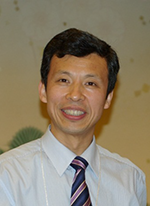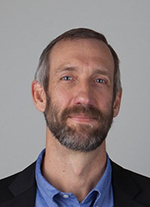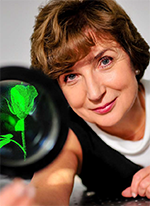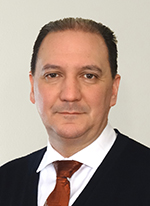Manufacturing and metrology in developing optical systems
Fengzhou Fang
Tianjin University, China
University College Dublin, Ireland
Abstract
To upgrade the manufacturing technology from "precision manufacturing”, "high performance manufacturing” to the next generation of manufacturing of “Manufacturing III”, a new breakthrough should be made to achieve a leap-frog development. Different to conventional manufacturing, the fundamentals of "Manufacturing III” is beyond the scope of conventional theory. It is based on new principles and theories at the atomic and/or close-to-atomic scale, i.e., ACSM. This keynote speech will address the key issues in ACSM from concept to main characteristics. Following the introduction of Manufacturing III, manufacturing and metrology of developing freeform optical systems will be discussed.
Biography
Professor Fengzhou Fang has been working in manufacturing science and technology since he became a faculty member at university in 1982. He was responsible for setting up the Centre of Micro/nano Manufacturing Technology (MNMT) at Tianjin University in 2005, which has been recognised as a leading manufacturing research organization in the world. He has managed a large number of national, international, and industry funded research projects. His specialist areas of interest include micro/nano manufacturing, optical freeform manufacturing, bio-medical manufacturing, ultra-precision machining and metrology. He is a fellow of the International Academy for Production Engineering (CIRP), the International Society for Nanomanufacturing (ISNM), and the Society of Manufacturing Engineers (SME). He served as a council member of CIRP, the chairman of the CIRP Manufacturing Curriculum Committee, and a board member of the Asian Society for Precision Engineering & Nanotechnology (ASPEN). He is the founding president of ISNM and the editor-in-chief of Nanomanufacturing and Metrology (N&M).
Evaluating the performance of optical surface topography measurement systems using the Instrument Transfer Function
Peter J. de Groot
Zygo Corporation, USA
Abstract
Of basic importance in the development and use of interferometers that measure surface topography is a characterization of the instrument response. One way to do this is with the instrument transfer function or ITF, which maps the spatial frequency content of the surface topography to the measurement result, using a table of constant coefficients for each spatial frequency. The ITF is an increasingly common specification for instruments that measure the form and waviness of optical components such as mirrors, lenses and optical flats, as well as for instruments that measure fine-scale texture and surface structure. In this tutorial presentation, I clarify the meaning of the ITF, provide methods for evaluating the ITF quantitatively, and outline modeling methods that allow for predicting instrument response from optical imaging theory.
Biography
Dr. Peter de Groot is the Executive Director of R&D at Zygo Corporation, where he manages and contributes to innovation and new product discovery. He is an Honorary Professor at the University of Nottingham, a member of the Board of Directors of the SPIE, and an active member of the Applied Optics community as a lecturer and author.
Metrological aspects of 3D quantitative imaging for biomedical and engineering applications
Malgorzata Kujawinska
Warsaw University of Technology, Poland
Abstract
Label-free quantitative 3D phase imaging techniques are becoming increasingly important and popular in biological and medical applications as well as in industrial control of microobjects with optical functionality. The most popular methods to deliver 3D refractive index distribution in these microobjects is optical diffraction tomography (ODT) with its most common realization through holographic projections. However due to complexity of projection capture scenarios and tomographic reconstruction procedures the results represent different values and distributions in a measurement volume. Quantification of these errors will benefit both users and developers of ODT providing not only more reliable and comparative measurement results, but also facilitate evolution of hardware and software.
In the talk at first the state-of the-art in the field ODT and its applications will be presented. Next the main metrological aspects of these systems will be discussed and the possibility of utilizing calibrated phantom to quantify their basic parameters like resolution, accuracy of retrieved morphology or absolute RI value will be presented.
Biography
Malgorzata Kujawinska PhD DSc., SPIE Fellow, Full Professor of applied optics at Warsaw University of Technology, head of Photonics Engineering Division at Institute of Micromechanics and Photonics. Expert in full-field optical metrology and 3D imaging, development of novel photonics measurement systems, data analysis for metrology and its applications in multimedia and biomedical engineering. Recently focusing on quantitative phase imaging and holographic tomography systems for biomedical applications at cellular level. Author of one monograph, several book chapters and more than 200 papers in international scientific journals. She had been the 2005 SPIE President , v-ce President of European Technology Platform Photonics21 (2005-2016) and recipient of SPIE 2013 Chandra S. Vikram Award in Optical Metrology.
Multiwavelength Interferometric distance sensor for flexible and highest quality metrology in modern optics manufacturing
Jürgen Petter
Ametek Inc., BU Taylor Hobson, USA
Abstract
In todays optics manufacturing the demand on precision on the on hand and shape - aspheric or freeform - on the other hand is steadily increasing. While modern optical designs challenge the form and shape of optical components the need on quality in contour accuracy and surface finish grows.
A sensor based on Multiwavelength-Interferometric distance measurement provides the core technology to enable a non-contact quality control system to allow for a highly flexible and accurate form and surface metrology system. A 4-axis non-contact scanning of the spheric, aspheric or freeform optic is realized to compare the actual shape and surface quality of the object with the theoretical design. Here, also optics with inflection points (Gull-wings), steep slopes of even hemispheres can be measured. Furthermore, the MWLI-technology of the sensor also allows for the measurement of segmented optics, asphero-diffractive or fresnel optics.
The talk will give an insight into the basic functionality of the sensor technology and also the realization of the non-contact scanning metrology system. A variety of examples of application will be presented.
Biography
2003 PhD in Physics at Institute of Applied Physics, Darmstadt University of Technology
2001-2007 Scientific assistant, group leader of scientific group
2006 Co-founder and CEO and managing partner of Luphos GmbH, Non-contact Optics metrology solutions
2014 Transfer of Luphos GmbH to Ametek Inc. as part of Taylor Hobson Ltd.
Since 2014 Member of Board, Taylor Hobson Ltd.
Business Director for Luphos technology
Since 2015 Assistant Lecturer at Technical University Deggendorf
Since 2015 Member of Board of Optence e.V.
Since 2019 Business Director Optics Metrology Systems at Taylor Hobson Ltd.
Memberships: DPG (Germany Physical Society), SPIE
 您当前的位置:Keynote Speakers
您当前的位置:Keynote Speakers



